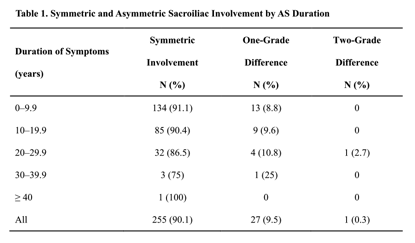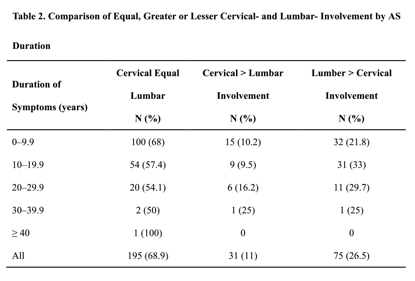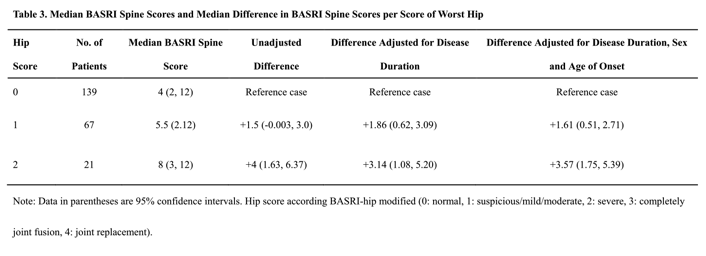Session Information
Date: Sunday, October 21, 2018
Session Type: ACR Poster Session A
Session Time: 9:00AM-11:00AM
Background/Purpose: Structural damage is a major cause of poor outcomes in patients with ankylosing spondylitis (AS). In China, structural damage characteristics of AS are rarely reported. We evaluated radiographic changes in sacroiliac (SI), spine and hip joints in Chinese AS patients, and compared structural damage with other races.
Methods: This study included 283 AS patients per the modified New York criteria. Computed tomography (CT) scans and lumbar/cervical X-rays were used to detect structural damage in SI joint and spine. Disease severity was assessed by BASRI-SI, BASRI-spine and BASRI-hip scored by a trained rheumatologist and a musculoskeletal radiologist where the inter-rater reliability (average kappa: 87.3%) was excellent. Adjusted median BASRI spine score per severity of hip arthritis was calculated using median regression.
Results: There were respectively 94 (33.2%), 98 (34.6%) and 91 (32.2%) patients with mild (BASRI-SI average: 2), moderate (2.5-3.5) and severe (4) structural damage of SI joint. 91.2% and 90.1% patients displayed bilateral symmetric sacroiliitis in the first decade and the whole duration, respectively. In patients with asymmetric sacroiliitis, more injuries were detected in left sacroiliac joints than the right. In early AS, more cervical and lumbar involvement was separately detected in 10.2 % and 21.8 % patients. In the whole duration, 68.9% patients had equal lumbar and cervical involvement. Median BASRI-spine was 4. 28 (9.8%) patients progressed to complete spinal fusion. The frequency of hip joint involvement was 41.2%. Higher hip scores were associated with worse BASRI-spine scores. Compared with the results from US AS patients (n=769) [PMID: 20971774], our patients had more symmetric structural damage in SI joints and more cervical involvement in early disease. Comparing hip involvement with other races (24% for Spanish, 29% for Belgian, and 36% for Ibero-American) [PMID: 19605374] revealed Chinses AS patients (41.2%) had more hip structural damage.
Conclusion: Chinese AS patients had more symmetric structural damage in SI joints, more cervical involvement in early disease and more hip structural damage than reported in patients of other races. Using a more sensitive method of detection of SI and hip joint severity (CT scans) may explain part of these results.
To cite this abstract in AMA style:
Kong W, Jefferies C, Learch T, Cui J, Gan X, Zhang N, Zhang Y, Wang J, Tao Q, Yan X, Weisman M, Ishimori M. Structural Damage Characteristics of Patients with Ankylosing Spondylitis in China [abstract]. Arthritis Rheumatol. 2018; 70 (suppl 9). https://acrabstracts.org/abstract/structural-damage-characteristics-of-patients-with-ankylosing-spondylitis-in-china/. Accessed .« Back to 2018 ACR/ARHP Annual Meeting
ACR Meeting Abstracts - https://acrabstracts.org/abstract/structural-damage-characteristics-of-patients-with-ankylosing-spondylitis-in-china/



